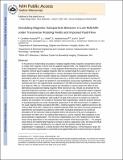| dc.contributor.author | Wald, L.L. | |
| dc.contributor.author | Cantillon-Murphy, Padraig | |
| dc.contributor.author | Adalsteinsson, Elfar | |
| dc.contributor.author | Zahn, Markus | |
| dc.date.accessioned | 2015-10-02T16:58:22Z | |
| dc.date.available | 2015-10-02T16:58:22Z | |
| dc.date.issued | 2010-04 | |
| dc.date.submitted | 2010-03 | |
| dc.identifier.issn | 03048853 | |
| dc.identifier.uri | http://hdl.handle.net/1721.1/99129 | |
| dc.description.abstract | In the presence of alternating-sinusoidal or rotating magnetic fields, magnetic nanoparticles will act to realign their magnetic moment with the applied magnetic field. The realignment is characterized by the nanoparticle's time constant, ττ. As the magnetic field frequency is increased, the nanoparticle's magnetic moment lags the applied magnetic field at a constant angle for a given frequency, Ω, in rad s[superscript −1]. Associated with this misalignment is a power dissipation that increases the bulk magnetic fluid's temperature which has been utilized as a method of magnetic nanoparticle hyperthermia, particularly suited for cancer in low-perfusion tissue (e.g., breast) where temperature increases of between 4 and 7 °C above the ambient in vivo temperature cause tumor hyperthermia. This work examines the rise in the magnetic fluid's temperature in the MRI environment which is characterized by a large DC field, B[subscript 0]. Theoretical analysis and simulation is used to predict the effect of both alternating-sinusoidal and rotating magnetic fields transverse to B[subscript 0]. Results are presented for the expected temperature increase in small tumors (~1 cm radius) over an appropriate range of magnetic fluid concentrations (0.002–0.01 solid volume fraction) and nanoparticle radii (1–10 nm). The results indicate that significant heating can take place, even in low-field MRI systems where magnetic fluid saturation is not significant, with careful the goal of this work is to examine, by means of analysis and simulation, the concept of interactive fluid magnetization using the dynamic behavior of superparamagnetic iron oxide nanoparticle suspensions in the MRI environment. In addition to the usual magnetic fields associated with MRI, a rotating magnetic field is applied transverse to the main B[subscript 0] field of the MRI. Additional or modified magnetic fields have been previously proposed for hyperthermia and targeted drug delivery within MRI. Analytical predictions and numerical simulations of the transverse rotating magnetic field in the presence of B[subscript 0] are investigated to demonstrate the effect of Ω, the rotating field frequency, and the magnetic field amplitude on the fluid suspension magnetization. The transverse magnetization due to the rotating transverse field shows strong dependence on the characteristic time constant of the fluid suspension, τ. The analysis shows that as the rotating field frequency increases so that Ωτ approaches unity, the transverse fluid magnetization vector is significantly non-aligned with the applied rotating field and the magnetization's magnitude is a strong function of the field frequency. In this frequency range, the fluid's transverse magnetization is controlled by the applied field which is determined by the operator. The phenomenon, which is due to the physical rotation of the magnetic nanoparticles in the suspension, is demonstrated analytically when the nanoparticles are present in high concentrations (1–3% solid volume fractions) more typical of hyperthermia rather than in clinical imaging applications, and in low MRI field strengths (such as open MRI systems), where the magnetic nanoparticles are not magnetically saturated. The effect of imposed Poiseuille flow in a planar channel geometry and changing nanoparticle concentration is examined. The work represents the first known attempt to analyze the dynamic behavior of magnetic nanoparticles in the MRI environment including the effects of the magnetic nanoparticle spin-velocity. It is shown that the magnitude of the transverse magnetization is a strong function of the rotating transverse field frequency. Interactive fluid magnetization effects are predicted due to non-uniform fluid magnetization in planar Poiseuille flow with high nanoparticle concentrations. | en_US |
| dc.description.sponsorship | R. J. Shillman Career Development Award | en_US |
| dc.description.sponsorship | Thomas and Gerd Perkins Professorship Award | en_US |
| dc.description.sponsorship | MIT Dean's Fellowship | en_US |
| dc.description.sponsorship | National Institutes of Health (U.S.) (Award R01 EB007942) | en_US |
| dc.language.iso | en_US | |
| dc.publisher | Elsevier | en_US |
| dc.relation.isversionof | http://dx.doi.org/10.1016/j.jmmm.2010.03.029 | en_US |
| dc.rights | Creative Commons Attribution-Noncommercial-NoDerivatives | en_US |
| dc.rights.uri | http://creativecommons.org/licenses/by-nc-nd/4.0/ | en_US |
| dc.source | PMC | en_US |
| dc.title | Simulating magnetic nanoparticle behavior in low-field MRI under transverse rotating fields and imposed fluid flow | en_US |
| dc.type | Article | en_US |
| dc.identifier.citation | Cantillon-Murphy, P., L.L. Wald, E. Adalsteinsson, and M. Zahn. “Simulating Magnetic Nanoparticle Behavior in Low-Field MRI under Transverse Rotating Fields and Imposed Fluid Flow.” Journal of Magnetism and Magnetic Materials 322, no. 17 (September 2010): 2607–17. | en_US |
| dc.contributor.department | Massachusetts Institute of Technology. Department of Electrical Engineering and Computer Science | en_US |
| dc.contributor.mitauthor | Cantillon-Murphy, Padraig | en_US |
| dc.contributor.mitauthor | Adalsteinsson, Elfar | en_US |
| dc.contributor.mitauthor | Zahn, Markus | en_US |
| dc.relation.journal | Journal of Magnetism and Magnetic Materials | en_US |
| dc.eprint.version | Author's final manuscript | en_US |
| dc.type.uri | http://purl.org/eprint/type/JournalArticle | en_US |
| eprint.status | http://purl.org/eprint/status/PeerReviewed | en_US |
| dspace.orderedauthors | Cantillon-Murphy, P.; Wald, L.L.; Adalsteinsson, E.; Zahn, M. | en_US |
| dc.identifier.orcid | https://orcid.org/0000-0002-7637-2914 | |
| dc.identifier.orcid | https://orcid.org/0000-0003-2228-2347 | |
| dc.identifier.orcid | https://orcid.org/0000-0001-6679-2889 | |
| mit.license | PUBLISHER_CC | en_US |
| mit.metadata.status | Complete | |
